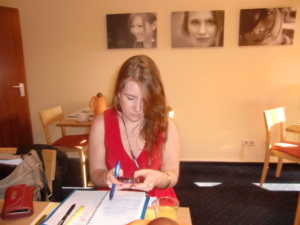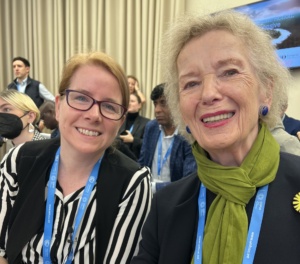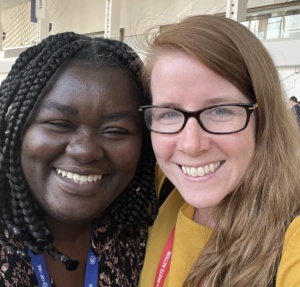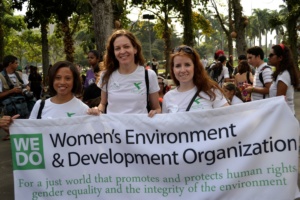by Bridget Burns, Executive Director
This year, I turned 40 on International Women’s Day—and today, one month later, I mark 15 years with WEDO. The convergence of these milestones feels less like a celebration and more like a gentle pause: a moment to look back, take stock, and feel rooted in time. It also happens to be WEDO’s 35th anniversary—a reminder that our histories, both personal and organizational, are deeply intertwined. Together, they’ve made me more aware of where I stand in the arc of things—not at the beginning, but with enough distance to see how far we’ve come (and yes, occasionally wondering how time managed to pass this quickly).
I started at WEDO as an intern, fresh from grad school and my first job—wide-eyed and slightly overdressed—not knowing this organization would become the professional and political home I’d grow up inside. Six years into my role as Executive Director, I still feel the presence of every version of myself that came before.
Just two weeks ago at CSW, I found myself in a room honoring the legacy of the women’s movement in shaping multilateralism—celebrating not only our collective contributions but also the 30th anniversary of the Beijing Platform for Action. I sat beside the brilliant Charlotte Bunch, one of the first people I met at WEDO when I walked into a GEAR campaign meeting advocating for the creation of UN Women. Last month, surrounded by feminist thinkers, doers, and dreamers across generations, I felt the quiet truth of being in the middle—not just in life, but in leadership. Not new, not yet an elder. A bridge between what’s been built and what is still being imagined. So, if I wax nostalgic here, I hope you’ll indulge me.
I’ve been reflecting not only on how much the world has changed in these 15 years but also on how deeply the work itself has been transformed—how we organize, how we communicate, how we share power and vision across borders. The terrain feels almost unrecognizable from when I began. And yet, some things remain beautifully intact: the values that guide us, the principles we return to, and the collective dreams that keep pulling us forward.
When I joined WEDO in 2010, the global political landscape was already shifting, though none of us could yet grasp the scale of what was coming. The world was still recovering from the shock of the 2008 financial crisis. The Arab Spring had not yet begun. Climate finance was still more aspiration than reality—the Green Climate Fund had just been established but remained empty and untested. We were preparing for COP16 in Cancún, where the Cancun Agreements aimed to rebuild trust after the collapse in Copenhagen and, we hoped, to embed gender equality more clearly across decisions on mitigation, adaptation, and finance. That same year, the Deepwater Horizon oil spill offered a devastating, real-time reckoning with fossil fuel dependency, while the creation of UN Women marked a long-overdue step forward for the global architecture of gender equality.
Since then, the terrain has shifted dramatically. We’ve seen the Paris Agreement adopted with a groundbreaking reference to human rights and gender equality, and mandates for gender-responsive approaches embedded across climate policies—from mitigation and adaptation to finance and technology. Gender Action Plans now guide implementation under the UNFCCC and across every major climate finance institution. What once felt aspirational is now, at least on paper, institutionalized. Feminist movements have become powerful forces in shaping multilateral climate processes—where their presence was once emerging, it is now indispensable. The Women and Gender Constituency, which today anchors a vibrant network of thousands of advocates around the world, had just submitted its request for official recognition when I joined.
But the context is also more volatile: the climate crisis has intensified in scale and urgency, authoritarianism is on the rise, civic space continues to shrink, and disinformation now floods our information ecosystems. Social media, once a frontier for organizing, has become a battleground for attention and power. We’ve witnessed real gains for women in leadership—and real backlash. And we’ve learned, again and again, that every victory must be defended.
The way we do the work has evolved just as rapidly. In 2010, global advocacy was still deeply physical and analog. At UNFCCC meetings, we’d queue at the document desk each morning to collect the printed daily program or hunt for the latest version of the negotiation text. I still remember one night in Bonn—back when meetings were held at the Maritim Hotel—leaving dinner with a friend to return to the venue and pick up a new printed draft, then sitting with highlighters and pens to mark it up. Each delegation had a mailbox. If we wanted to invite Parties to a reception, we designed a flyer, printed it, and delivered it to every country’s slot. Translation was slow and costly, so most sessions were in one or two languages. Time zone coordination was done manually, and conference calls—often glitchy and chaotic—were the norm. Movements were still largely offline.
We printed everything: talking points, sign-up sheets, agendas. PowerPoint was our primary tool. Shared drives were just catching on—Dropbox felt revolutionary—so I wore a USB drive around my neck like it was a VIP pass to the feminist future. I had a Blackberry. “Remote work” meant checking email in an airport café and hoping the Wi-Fi would hold long enough to hit “send.” There was no talk of digital burnout, because we weren’t always online. Storytelling came in the form of long-form blogs, published days or weeks after the moment had passed. It was a slower, more tactile era. Urgent, yes—but somehow still spacious.
Today, we live in an entirely different rhythm. We host daily Zoom meetings with simultaneous interpretation. We coordinate across continents in Signal groups. We build communications strategies for Instagram and LinkedIn—once Twitter, now increasingly Bluesky. We record podcasts, share videos, use Deepl for rapid translation, and design infographics in Canva. We’ve even built an app to track gender mentions under the UNFCCC. We’re also reckoning with AI—its possibilities, its extractive logic, its threat to truth. The work is more dynamic, more visible, and more vulnerable. It’s more connected, and more exhausting. But also, somehow, more creative.
This evolution has taught me to lead differently. The pace has quickened, but so has the need for pause—for reflection, for boundaries, for care. I’ve learned that tools don’t build movements—people do. And people need space: for rest, for grief, for joy, for transformation. While technology has expanded our reach, it has also demanded new forms of stewardship—of stories, relationships, attention, and energy. The shift from printed flyers to podcast scripts, from pen-marked documents to real-time collaborative editing, has made us more agile, but not necessarily lighter. What sustains me is what always has: the wisdom of feminist movements, the power of deep collaboration, and the belief that systems can shift—because people can.
Looking back, I’m struck not just by what’s changed, but by how fast and uneven the change has been. In 2010, climate finance was a promise; today, it’s a fight over delivery and justice. In 2010, women held 19% of seats in national parliaments; today, it’s around 26.5%—still far from parity. The rights and knowledge of Indigenous peoples were often sidelined in global climate processes; today, while still contested, their leadership is increasingly recognized as essential to climate solutions and stewardship. The arc is not linear. The wins are hard-won. And yet, through every shock and shift, feminist organizing has adapted, persisted, and reimagined what’s possible.
And still—what hasn’t changed is the clarity of what we’re fighting for. A world where care is at the center. Where power is shared. Where the rights of women and marginalized communities are not up for debate. And where climate justice is a given, not a question. What hasn’t changed is the necessity of global solidarity, of feminist leadership, of joyful resistance. What hasn’t changed is the belief that we are stronger together—and that even in the face of backlash, erosion, or fatigue, we carry with us the memory of our wins and the strategies that made them possible.
If you’re still reading, I’m impressed. In 2010, this would’ve been a downloadable PDF, and you’d be emailing me to say the file was too big to open.
Fifteen years in, I know this work is not a sprint, and it’s not a straight line. There are days when the pace of crisis feels unbearable—when the threats are too loud, and the progress too quiet. But I also know how much is possible in a decade. I’ve seen policies shift, movements scale, narratives transform, and leaders rise. I’ve seen young activists grow into seasoned advocates. I’ve seen rooms open, coalitions build, and solidarity deepen. The future is uncertain, yes—but it is still ours to shape. And it will take all of us.
So if this moment feels exhausting, it’s because we are in the thick of the work. If it feels like something is slipping away, it’s also because something new is being born. Our task now is not only to endure, but to imagine—to be agile in how we organize, but unwavering in what we fight for. To hold on to the progress we’ve made, and keep pulling it forward. To keep showing up, together, for the world we know is possible.








